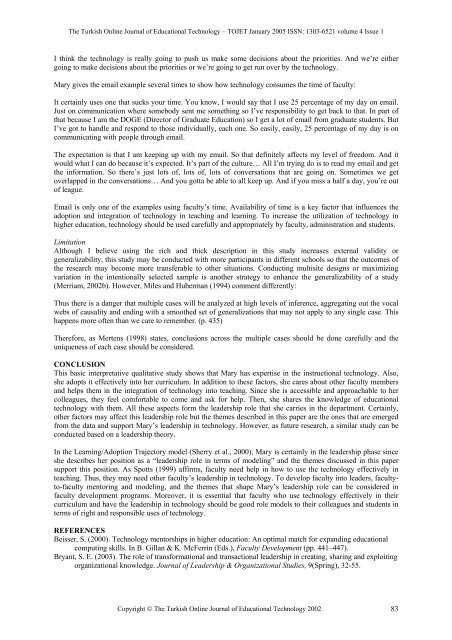Age - TOJET the Turkish online journal of educational technology
Age - TOJET the Turkish online journal of educational technology
Age - TOJET the Turkish online journal of educational technology
You also want an ePaper? Increase the reach of your titles
YUMPU automatically turns print PDFs into web optimized ePapers that Google loves.
The <strong>Turkish</strong> Online Journal <strong>of</strong> Educational Technology – <strong>TOJET</strong> January 2005 ISSN: 1303-6521 volume 4 Issue 1<br />
I think <strong>the</strong> <strong>technology</strong> is really going to push us make some decisions about <strong>the</strong> priorities. And we’re ei<strong>the</strong>r<br />
going to make decisions about <strong>the</strong> priorities or we’re going to get run over by <strong>the</strong> <strong>technology</strong>.<br />
Mary gives <strong>the</strong> email example several times to show how <strong>technology</strong> consumes <strong>the</strong> time <strong>of</strong> faculty:<br />
It certainly uses one that sucks your time. You know, I would say that I use 25 percentage <strong>of</strong> my day on email.<br />
Just on communication where somebody sent me something so I’ve responsibility to get back to that. In part <strong>of</strong><br />
that because I am <strong>the</strong> DOGE (Director <strong>of</strong> Graduate Education) so I get a lot <strong>of</strong> email from graduate students. But<br />
I’ve got to handle and respond to those individually, each one. So easily, easily, 25 percentage <strong>of</strong> my day is on<br />
communicating with people through email.<br />
The expectation is that I am keeping up with my email. So that definitely affects my level <strong>of</strong> freedom. And it<br />
would what I can do because it’s expected. It’s part <strong>of</strong> <strong>the</strong> culture… All I’m trying do is to read my email and get<br />
<strong>the</strong> information. So <strong>the</strong>re’s just lots <strong>of</strong>, lots <strong>of</strong>, lots <strong>of</strong> conversations that are going on. Sometimes we get<br />
overlapped in <strong>the</strong> conversations… And you gotta be able to all keep up. And if you miss a half a day, you’re out<br />
<strong>of</strong> league.<br />
Email is only one <strong>of</strong> <strong>the</strong> examples using faculty’s time. Availability <strong>of</strong> time is a key factor that influences <strong>the</strong><br />
adoption and integration <strong>of</strong> <strong>technology</strong> in teaching and learning. To increase <strong>the</strong> utilization <strong>of</strong> <strong>technology</strong> in<br />
higher education, <strong>technology</strong> should be used carefully and appropriately by faculty, administration and students.<br />
Limitation<br />
Although I believe using <strong>the</strong> rich and thick description in this study increases external validity or<br />
generalizability, this study may be conducted with more participants in different schools so that <strong>the</strong> outcomes <strong>of</strong><br />
<strong>the</strong> research may become more transferable to o<strong>the</strong>r situations. Conducting multisite designs or maximizing<br />
variation in <strong>the</strong> intentionally selected sample is ano<strong>the</strong>r strategy to enhance <strong>the</strong> generalizability <strong>of</strong> a study<br />
(Merriam, 2002b). However, Miles and Huberman (1994) comment differently:<br />
Thus <strong>the</strong>re is a danger that multiple cases will be analyzed at high levels <strong>of</strong> inference, aggregating out <strong>the</strong> vocal<br />
webs <strong>of</strong> causality and ending with a smoo<strong>the</strong>d set <strong>of</strong> generalizations that may not apply to any single case. This<br />
happens more <strong>of</strong>ten than we care to remember. (p. 435)<br />
Therefore, as Mertens (1998) states, conclusions across <strong>the</strong> multiple cases should be done carefully and <strong>the</strong><br />
uniqueness <strong>of</strong> each case should be considered.<br />
CONCLUSION<br />
This basic interpretative qualitative study shows that Mary has expertise in <strong>the</strong> instructional <strong>technology</strong>. Also,<br />
she adopts it effectively into her curriculum. In addition to <strong>the</strong>se factors, she cares about o<strong>the</strong>r faculty members<br />
and helps <strong>the</strong>m in <strong>the</strong> integration <strong>of</strong> <strong>technology</strong> into teaching. Since she is accessible and approachable to her<br />
colleagues, <strong>the</strong>y feel comfortable to come and ask for help. Then, she shares <strong>the</strong> knowledge <strong>of</strong> <strong>educational</strong><br />
<strong>technology</strong> with <strong>the</strong>m. All <strong>the</strong>se aspects form <strong>the</strong> leadership role that she carries in <strong>the</strong> department. Certainly,<br />
o<strong>the</strong>r factors may affect this leadership role but <strong>the</strong> <strong>the</strong>mes described in this paper are <strong>the</strong> ones that are emerged<br />
from <strong>the</strong> data and support Mary’s leadership in <strong>technology</strong>. However, as future research, a similar study can be<br />
conducted based on a leadership <strong>the</strong>ory.<br />
In <strong>the</strong> Learning/Adoption Trajectory model (Sherry et al., 2000), Mary is certainly in <strong>the</strong> leadership phase since<br />
she describes her position as a “leadership role in terms <strong>of</strong> modeling” and <strong>the</strong> <strong>the</strong>mes discussed in this paper<br />
support this position. As Spotts (1999) affirms, faculty need help in how to use <strong>the</strong> <strong>technology</strong> effectively in<br />
teaching. Thus, <strong>the</strong>y may need o<strong>the</strong>r faculty’s leadership in <strong>technology</strong>. To develop faculty into leaders, facultyto-faculty<br />
mentoring and modeling, and <strong>the</strong> <strong>the</strong>mes that shape Mary’s leadership role can be considered in<br />
faculty development programs. Moreover, it is essential that faculty who use <strong>technology</strong> effectively in <strong>the</strong>ir<br />
curriculum and have <strong>the</strong> leadership in <strong>technology</strong> should be good role models to <strong>the</strong>ir colleagues and students in<br />
terms <strong>of</strong> right and responsible uses <strong>of</strong> <strong>technology</strong>.<br />
REFERENCES<br />
Beisser, S. (2000). Technology mentorships in higher education: An optimal match for expanding <strong>educational</strong><br />
computing skills. In B. Gillan & K. McFerrin (Eds.), Faculty Development (pp. 441–447).<br />
Bryant, S. E. (2003). The role <strong>of</strong> transformational and transactional leadership in creating, sharing and exploiting<br />
organizational knowledge. Journal <strong>of</strong> Leadership & Organizational Studies, 9(Spring), 32-55.<br />
Copyright © The <strong>Turkish</strong> Online Journal <strong>of</strong> Educational Technology 2002 83
















